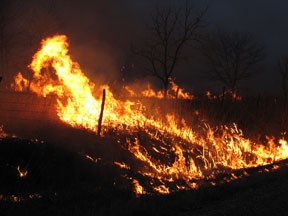
NPS Photo Grazing animals play an important role maintaining the ecosystem by stimulating plants growth. This triggers biological activity and nutrient exchanges. Bison, deer, and cattle compact the soil with their hooves and open new areas for seeds to germinate and take root. The role of fire is prevalent in almost every ecosystem. However, few involve fire as frequently as prairie. Tallgrass prairie can accumulate an enormous amount of biomass (dead plants) in one year. Leaves die in the fall and roots go dormant during cold winter months. New shoots emerge the following spring. As years progress, the dead leaf litter accumulates, covering the ground in a thick thatch. New shoots find it harder to take in sunlight. The insulated ground stays cold, delaying spring plant growth. Plant nutrients stay locked away in the slowly decaying leaf litter. Grazers such as bison and cattle, expend more energy foraging for nutritious new foliage through the dead leaves. The leaf litter smothers and weakens prairie plants as it accumulates. Trees and woody bushes are able to invade stressed prairies. Trees create shade restricting further sunlight for plants that need full sun. Fire is nature's way of starting over. Fires naturally start when lightning ignites flammable material. Plants normally take months or years to decay. Fire transforms the tied-up nutrients within seconds to ash, a form usable by plants. Sunlight warms the blackened ground stimulating dormant plants to sprout. Grazers feed uninhibited by dead litter, further stimulating growth. The intense heat kills trees and shrubs with exposed stems and branches, opening the ground to full sunlight again. Most ecologists agree that for the last 5,000 years, prairie vegetation would have diminished if not for the burning of these grasslands. Plains Indians observed how fires or "Red Buffalo" attracted game to new grasses. Mimicking nature by burning the prairie in desirable locations, they insured the growth of fresh, highly nutritious shoots of native grasses. Undeniable evidence shows the massive herds of bison ranged hundreds, sometimes thousands of miles to find areas of fresh green growth. Early plains peoples survived using fire to cultivate grazing areas, which reduced tracking and hunting times. Hunter-gathers and later organized tribes were North America’s first large-scale land managers. The prairie has long been known for its incredible fertility. Settlers eagerly plowed the soils to plant crops of corn, wheat, sorghum, and other vegetables. Domestic crops are various forms of grasses which grow well in prairie soils. Today, one American farmer proudly feeds 129 people, a testimony to the rich prairie soils. However, the give-and-take nutrient exchange by complex organisms cannot survive on a single crop "monoculture." The fertility of the soil is lost over time without replacing nutrients taken out. Rotating crops, leaving land to rest and using fertilizer offsets this loss. In the Flint Hills this fertility feeds cattle on the rich prairie grasses. A steer can gain almost 2 pounds per day pasturing on the nutritious bluestem grass. Modern day ranchers use fires to improve cattle forage and prairie health. Learn more about managing fire and smoke in the Flint Hills. Read More About Fire in the Prairie |
Last updated: April 9, 2022
